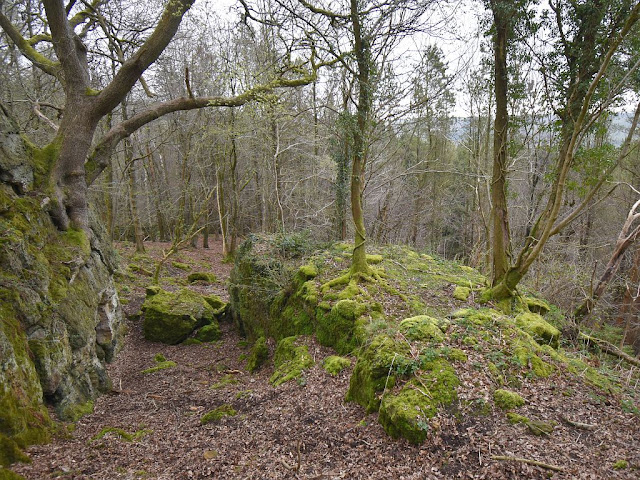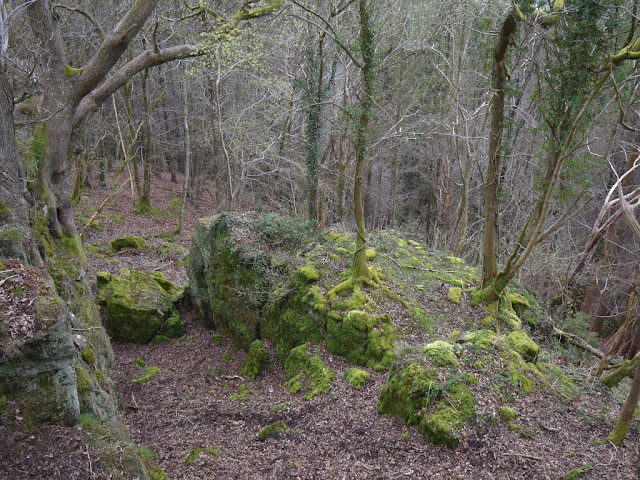"Where mighty masses of stone stare down,
there they have their Fairy houses.
There they eat at the Fairy Table."

|
|
The Fairy Table outcrop |
The Fairy Table is a rock outcrop located on a wooded hillside,
one mile to the north-east of Kilburn village on the edge of the North York
Moors.
The outcrop is marked on the first edition OS map (1856), so it had some local significance before this date, but there appears to be nothing on record to explain the interesting name.
There is another rock outcrop called the 'Fairies Table' located on the wooded slopes leading down to the river Lyne, to the north of Carlisle in Cumbria. This is described as a large flat topped rock on which the fairies would dance on moonlit nights. The fairies were also said to live in a cave nearby.

|
|
Kilburn Fairy Table - OS Map
(map credit NLS) |
Further afield there is a 'La Table Des Fées' (The Fairies Table) at Bohan in Belgium. This again is a flat topped rock outcrop on a wooded hillside, where the fairies were said to dance at night. At Fresnicourt-le-Dolmen in France there is another 'Table Des Fées', which is is actually the cap stone of a Neolithic burial chamber. The fairies or 'white damsels', were said to dance there, and would sometimes consent to be a god mother to newborn children (the original fairy godmother), helping and protecting the child throughout their life. There is also a 'Table Aux Fées' at Saulnières in Brittany, which is a flat topped boulder where the fairies were said to eat their food. These hungry fairies were busy in this area transporting large rocks to build 'la Roche Aux Fées' - another impressive neolithic passage tomb, roofed over with huge flat stones. Folklore records that this was built as a fairy dwelling place, and that the souls of good people were protected there.

|
| The lower section of the outcrop - The Table? |
the Fairy Table seems to be quite a widespread folklore theme, and this was confirmed to some extent by using google to translate 'the Fairy Table' into German, which produced 'Der Wilden Tisch'. A search for this term brought up another example at Bernhardswald in Germany, which again is a flat topped outcrop on a wooded hillside. The folklore here is of interest and worth quoting...
There is talk of a little man who climbed over hill and dale and when the sun went down came to the huge people in the Bernhardswald. He was very afraid and wanted to flee. But the giants called him back, refreshed him with food and drink, and prepared a bed of thin grass and soft moss for the night. As thanks, the little man granted the giants a wish. It was to be allowed to live forever and to do their thing in the forest. "Whoever listens in the silence can still hear them, the wild people, how they live their own lives in solitude," says the legend. Local historian Wilhelm Praesent once described the people in the Bernhardswald aptly. "Where mighty masses of stone stare down, there they have their 'wild houses'. There they eat at the 'wild table'. Her children protect the children of men when they pick berries, show medicinal herbs and show the way to the lost.”
In Germany the 'wilde leute' (wild folk) are part of the fairy family, and often connected with woodland and forests. At times they are described as dwarf or elf like, and at other times more like giants (as in the above quote). This size anomaly can also be seen at the Roche Aux fees, where the fairies transported the huge rocks in their aprons - suggesting that they too were of large size. In the Netherlands, similar Neolithic passages tombs built from large rocks are called Hunebeds, and again this translates as the 'Giant's Bed' or grave, from the belief that they were built by giants.

|
|
The lower section (east side) |
This folklore contradiction regarding the size of the Fairies (and Hobs) associated with a site has been noted elsewhere in the Arcanum pages. (see Fairies Parlour cave). The ability to change shape and size is a characteristic of supernatural beings, so this may be an explanation for the folklore, with an older belief evolving into separate faerie and giant figures associated with a site.
Unfortunately, any folklore connected with the Fairy Table at Kilburn seems to have been lost, but the lower, flat topped section of the crag might point to a similar story with the fairies dancing there on moonlit nights. As the fairies were believed to live 'where mighty masses of stone stare down', the local belief may have been that the 'Kilburn fairies' had their home in these crags, which extends for 100m or so along the hillside. This would be a similar arrangement to the fairies at Thirlby, who were said to live in the Fairies Parlour Cave, below the crags at Sutton Bank, 2 miles to north of Kilburn. Still further north, the Hob cave at Over Silton might suggest that fairy dwellings could be found at regular intervals all along the edge of the moors.
After thoughts
Did the Fairy Table rocks once serve a real purpose? There is still a widespread practice among some cultures of leaving food offerings and gifts for spirits that are believed to dwell within certain rocks, crags, and mountains. In most cases a particular rock served as a focus for this activity. In the UK there are records of people leaving milk offerings for the fairy folk in the hollows of cup marked rocks, so the practice is not unknown here. The Fairy Tables may have originally been places where offerings or gifts were left for the spirits (Faerie folk) who were thought to dwell within these rocky hillside locations.
It is also worth noting that before the tree planting and forestry took place, the hillside location of the outcrop would also provide extensive views overlooking the vale of York to the south.
From local enquires it appears that the Fairy Table Wood was sold some
years ago and it is unclear who owns it now. It does not appear to be part of
the open access woodland nearby, so who to contact regarding this interesting,
but long forgotten local history site, still requires further research.

|
| Where mighty masses of stone stare down |


Post a Comment